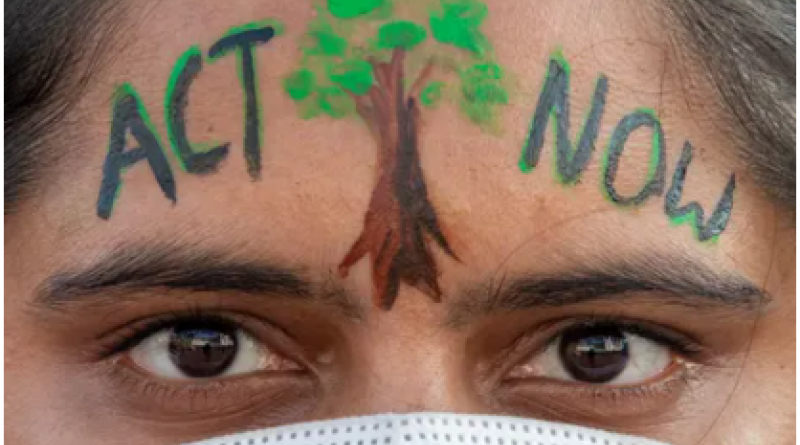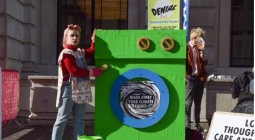Cop26 targets too weak to stop disaster, say Paris agreement architects

Figueres, Tubiana and Fabius warn that leaders must improve plans next year if world is to stay within crucial 1.5C limit
World leaders will have to return to the negotiating table next year with improved plans to cut greenhouse gases because the proposed targets agreed at the Cop26 summit are too weak to prevent disastrous levels of global heating, the three architects of the Paris agreement have warned.
Christiana Figueres, the former UN climate chief who oversaw the 2015 Paris summit, and Laurence Tubiana, the French diplomat who crafted the agreement, have told the Guardian the deadline is essential if the world is to avoid exceeding its 1.5C temperature limit. Laurent Fabius, the former French foreign minister who also oversaw Paris, added: “In the present circumstances [targets] must be enhanced next year.”
The last-ditch intervention by such senior figures, with the Glasgow talks reaching their final hours, reveals the heightened alarm among many experts over the chasm between carbon targets and the deep cuts necessary to limit temperature rises to 1.5C above pre-industrial levels.
Current national plans – known as nationally determined contributions (NDCs) – would lead to 2.4C of heating, according to an influential analysis this week by Climate Action Tracker.
Countries are currently expected to return with better pledges in 2025, but many are now demanding the deadline should be brought forward. This is seen as the most closely fought area of disagreement as the UK hosts struggle to broker a deal.
“If that [five years] is the first time that countries are called to increase their ambitions, honestly that’s going to be too late,” said Figueres, founding partner of the Global Optimism thinktank.
“This is critically important. We need much more urgency, as this is the critical decade. We need to come back next year. We can’t wait five years for new NDCs.”
Figueres and Tubiana said forcing countries to return with improved targets next year was allowed under the legal provisions of the Paris agreement. The European Union and the UN secretary-general, António Guterres, have also intervened to support the proposal. Guterres told the conference last week: “Let’s have no illusions: if commitments fall short by the end of this Cop, countries must revisit their national climate plans and policies. Not every five years. Every year.”
Tubiana, now chief of the European Climate Foundation, said: “It’s really important that we come back next year, and in 2023. That must be central to any outcome in Glasgow. This is necessary to fulfil the Paris agreement.”
Since the Paris agreement was signed, binding countries to limit temperature rises “well below” 2C above pre-industrial levels while “pursuing efforts” to a 1.5C limit, new science has shown that breaching the 1.5C threshold would lead to disastrous impacts, some irreversible, including the inundation of many low-lying areas. Heating has now reached 1.1C, and extreme weather is already taking hold around the world.
The Intergovernmental Panel on Climate Change has said emissions must be cut by 45% by 2030 to stay within 1.5C.
Figueres said the strengthened science means the five-yearly revisions – often called a “ratchet” – set out in the Paris agreement should be hastened. “The Paris agreement was deliberately written to continue to improve its provisions according to the best available science,” she added.
Tubiana also stressed that the spirit of the Paris agreement was based on climate science. “We must base decisions on the science,” said Tubiana. “That’s why we have the ratchet mechanism in the Paris agreement. We must agree to come back next year, as this gap [between NDCs and scientific advice] is a really big problem.”
Many other senior participants, observers and countries in the talks have also told the Guardian they back the call by Figueres and Tubiana.
Mary Robinson, chair of the Elders Group of senior statespeople, and previously a UN climate envoy, UN commissioner for human rights and president of Ireland, said: “They have to come back next year, that is needed to fulfil the terms of the Paris agreement. We need much more urgency, we need pressure. How can we say we are aligned with 1.5C if we don’t agree to come back?”
The question of when and how to revise NDCs is crucial because although the Glasgow talks will continue at least to the end of Friday, and probably well into this weekend, there is now no possibility that governments will toughen their NDCs at this summit. But a clause in the draft text that will form the main outcome of the talks would allow for a return next year to update and strengthen the targets.
The US also wants countries to have to come forward with stronger plans on a more frequent basis, but balks at the idea that all parties should have to revise their whole NDCs annually, as they can be complex documents involving multiple commitments across many government departments.
Xie Zhenhua, China’s head of delegation, said: “Whether the NDCs should be updated annually depends on what content is in it. Stable and long-term NDCS are more helpful for countries to carry out action to achieve targets.”
Xie also indicated that a “global stocktake” – a mechanism under the Paris agreement for countries to assess their NDCs in 2023 – might be a moment for revisions.
There may be room for compromise with the world’s two biggest emitters, who signed a surprise cooperative pact on Wednesday committing them to work together on emissions cuts in the next decade, in a major boost for the Cop26 summit.
A new draft outcome text is set to be drawn up by delegates in the early hours of Friday morning, and discussed ahead of the 6pm deadline for the talks to finish. However, previous Cop conferences have tended to go on well into Saturday and sometimes Sunday.
Other sticking points yet to be resolved in the draft text include climate finance for poor countries to help them cut carbon and cope with the impacts of extreme weather, and ways to help them with “loss and damage” – the ravages of extreme weather so severe that they cannot be prepared for or adapted to.
There are also question marks over how countries should monitor and report on their emissions, and controversial provisions for countries to use carbon trading or offsetting to help meet their emissions-cutting targets.
The Guardian
11 November 2021




